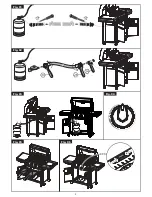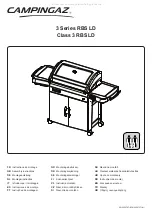
9
Triton PTS 3.0
Disconnecting the gas cylinder
1.
Close the cylinder valve (turn G2 clockwise).
2. Press G2 inwards and pull the regulator upwards.
3. Store the pressure regulator (G3) with the gas
hose (G6) under the barbecue. Make sure the gas
hose is not kinked or twisted in any way.
4. Store the gas cylinder correctly:
Do not store the gas cylinder in rooms below
ground level, in or near stairways, hallways
or passages and thoroughfares between buil-
dings.
–
Always store gas cylinders upright, even if they
are empty!
Connecting the gas cylinder
1. Press the regulator onto the gas cylinder outlet
Do not use any tools for this, as the cylinder valve
seal could be damaged in the process, resulting in
leaks.
2. Make sure that the pressure regulator (G5) and
the gas hose (G6) are securely connected.
3. Check to make sure the connection between the
pressure regulator (G3) and gas cylinder (G1) are
secure.
Make sure that the hose is not kinked or twisted in
any way and that it is not under tension.
4. Open the cylinder valve (turn G2 anti-clockwise)
and use a standard leak detector to make sure
that all of the connections are tight.
–
Please observe the instructions for the leak indi-
cator! Never check for leaks using a naked fla-
me. Listening for leaks is not a reliable method
of detection.
–
If a leak is detected, close the cylinder valve
immediately (turn G2 clockwise) and tighten
the loose connection or replace the leaking
part. Repeat the leak test.
5. If you do not wish to barbecue immediately, close
the cylinder valve (turn G2 clockwise).
Before starting
• Select a suitable, preferably wind-sheltered area
to set up the barbecue. Make sure that ...
–
there are not, and will not be, any flamma-
ble materials or substances in the vicinity. The
minimum distance to flammable materials or
substances must be 2 m overhead and 1 m to
the side of the barbecue; the distance to fla-
me-resistant materials or substances must be at
least 0.25 m.
–
the barbecue is positioned firmly on a suffici-
ently large area. It must not be moved during
operation.
• Do not use the gas cylinder in the cabinet, always-
beside the barbecue.
–
Never lay the gas cylinder on its side.
–
Do not kink the gas hose or apply a tension to
it.
• Make sure that the seal in the pressure regulator
(G4) is present and intact. Do not use any additi-
onal seals.
• When connecting the gas cylinder ensure that the-
re are no sources of ignition within a 5 m radius.
Important note: to avoid the risk of spark-over, do
not to light naked flames, do not smoke and do
not actuate the switches of electric devices (appli-
ances, lights, door bells, etc.).
Summary of Contents for Triton PTS 3.0
Page 15: ...15 Triton PTS 3 0 1 A B 4x A B 4x 2...
Page 16: ...16 Triton PTS 3 0 A B 4x 3 A B 4x 4...
Page 17: ...17 Triton PTS 3 0 5 6 A B 4x...
Page 18: ...18 Triton PTS 3 0 A B 16x 7 8 A B 4x 10 12 11...
Page 19: ...19 Triton PTS 3 0 9 10 A B 4x 14 13 A C 8x 16 17...
Page 20: ...20 Triton PTS 3 0 11 12 A B 2x 18 15...
Page 21: ...21 Triton PTS 3 0 14 13...
Page 22: ...22 Triton PTS 3 0 15 16 23 24...
Page 23: ...23 Triton PTS 3 0...










































